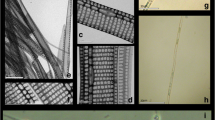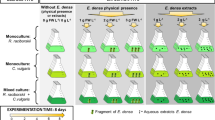Abstract
Anatoxin-a-concentration in cells ofAnabaena- andAphanizomenon-strains and in their growth media were studied in the laboratory in batch cultures at different temperatures, light fluxes, orthophosphate and nitrate concentrations and with different nitrogen sources for growth. Toxin concentrations were detected by HPLC. Also, the growth of the toxicAnabaena-strains was compared to that of a non-toxic one. The non-toxicAnabaena was never found to produce anatoxin-a. The amount of toxin in the cells of the toxic strains was high, often exceeding 1% of their dry weight. High temperature decreased the amount of the toxin regardless of growth. Growth limiting low and growth inhibiting high light decreased the amount of the toxin in the cells ofAnabaena-strains. The highest light flux studied did not limit the growth or decrease the level of the toxin in the cells ofAphanizomenon. Growth in N-free medium (i.e. N2 fixation) showed that the cells contained more toxin than growth in N-rich medium. Orthophosphate concentration had no effect on toxin levels, although the lowest concentrations limited the growth of all strains studied. The toxic strains tolerated higher temperatures than the non-toxic one, but the non-toxic strain seemed to be more adjustable to high irradiance than the toxic ones. The yields (dry weight) of non-toxic and toxic strains differed significantly in different phosphate concentrations.
Similar content being viewed by others
References
Berg K, Skulberg OM, Skulberg R (1987) Effects of decaying toxic blue-green algae on water quality — a laboratory study. Arch. Hydrobiol. 108: 549–563.
Bern L (1990) Food choice in some freshwater crustacean zooplankters. Acad. Diss., Uppsala Univ. Uppsala, 155 pp.
Carmichael WW (1986) Algal toxins. In Callow JR (ed.), Advances in Botanical Research 12. Academic Press, London, 47–101.
Carmichael WW (1988) Toxins of freshwater algae. In Tu AT (ed.), Handbook of Natural Toxins, vol. 3. Marine Toxins and Venoms. Marcel Dekker, New York, 121–147.
Carmichael WW (1992) Cyanobacteria secondary metabolites — the cyanotoxins. J. appl. Bact. 72: 445–459.
Carmichael WW, Gorham PR (1978) Anatoxins from clones ofAnabaena flos-aquae isolated from lakes of western Canada. Mitt. int. Ver. Limnol. 21: 285–295.
Codd GA, Edwards C, Beattie KA, Barr WM, Gunn GJ (1992) Fatal attraction to cyanobacteria. Nature 359: 110–111.
Codd GA, Poon GK (1988) Cyanobacterial toxins. In Gallon JG, Rogers LJ (eds), Proc. Phytochem. Soc. Europe, vol. 28. Oxford University Press, Oxford, 283–296.
DeMott WR, Moxter F (1991) Foraging on cyanobacteria by copepods: responses to chemical defences and resource abundance. Ecology 72: 1820–1834.
DeMott WR, Zhang Q-X, Carmichael WW (1991) Effects of toxic cyanobacteria and purified toxins on the survival and feeding of a copepod and three species ofDaphnia. Limnol. Oceanogr. 36: 1346–1357.
Devlin JP, Edwards OE, Gorham PR, Hunter NR, Pike RK, Stavric B (1977) Anatoxin-a toxic alkaloid fromAnabaena flos-aquae NRC-44h. Can. J. Chem. 55: 1367–1371.
Edwards C, Beattie KA, Scrimgeour CM, Codd GA (1992) Identification of anatoxin-a in benthic cyanobacteria (bluegreen algae) and in associated dog poisonings at Loch Insh, Scotland. Toxicon 30: 1165–1175.
Fujiki H, Suganuma M, Suguri H, Yoshizawa S, Takagi K, Nakayasu M, Ojika M, Yamada K, Yasumoto T, Moore RE, Sugimura T (1990) New tumor promoters from marine natural products. In Hall S, Strichartz G (eds), Marine Toxins. Origin, Structure, and Molecular Pharmacology. ACS Symposium series 418: 232–240.
Fulton III RS, Paerl HW (1987) Toxic and inhibitory effects of the blue-green algaMicrocystis aeruginosa on herbivorous zooplankton. J. Plankton Res. 9: 837–855.
Gorham PR (1962) Laboratory studies on the toxins produced by waterblooms of blue-green algae. Am. J. Public Health 52: 2100–2105.
Gorham PR (1964) Toxic algae. In Jackson D (ed.), Algae and Man. Plenum Publishing Corp., New York, 307–336.
Gorham PR, McLachlan J, Hammer UT, Kim WK (1964) Isolation and culture of toxic strains ofAnabaena flos-aquae (Lyngb.) de Bréb. Verb. int. Ver. Limnol. 15: 796–804.
Huber CS (1972) The crystal structure and absolute configuration of 2,9-diacetyl-9-azabicyclo(4,2,1)non-2,3-ene. Acta Crystallogr. Sect. B. 28: 2577-2582.
Huby NJS, Thompson P, Wonnacott S, Gallagher T (1991) Structural modification of anatoxin-a. Synthesis of model affinity ligands for the nicotinic acetylcholine receptor. J. Chem. Soc., Chem. Commun. 1: 243–245.
Kiviranta J, Sivonen K, Lahti K, Luukkainen R, Niemelä SI (1991) Production and biodegradation of cyanobacterial toxins — a laboratory study. Arch. Hydrobiol. 121: 281–294.
Koskinen AMP, Rapoport H (1985) Synthetic and conformational studies on anatoxin-a: a potent acetylcholine agonist. J. Med. Chem. 28: 1301–1309.
Kotai J (1972) Instructions for preparation of modified nutrient solution Z8 for algae. Norwegian Institute for Water Research, publication B-11/69. Blindern, Oslo, 5 pp.
Meriluoto JAO, Eriksson JE (1988) Rapid analysis of peptide toxins in cyanobacteria. J. Chromatogr. 438: 93–99.
Moore RE, Patterson ML, Carmichael WW (1988) New pharmaceuticals from cultured blue-green algae. In Fautin DG (ed.), Biomedical Importance of Marine Organisms. California Academy of Sciences, San Francisco, 143–150.
Pearson MJ, Ferguson AJD, Codd GA, Reynolds CS, Fawell JK, Hamilton RM, Howard SR, Attwood MR (1990) Toxic Blue-Green Algae. Water Quality Series No. 2. National Rivers Authority, London, 128 pp.
Peary JA, Gorham PR (1966) Influence of light and temperature on growth and toxin production byAnabaena flos-aquae. Abstract of paper presented at the annual meeting, Phycological Society of America, Collage Park Md. 14.19.08.1966, 3–4.
Repavich WM, Sonzogni WC, Standridge JH, Wedepohl RE, Meisner LF (1990) Cyanobacteria in Wisconsin waters: acute and chronic toxicity. Wat. Res. 24: 225–231.
Runnegar MTC, Falconer IR, Jackson ARB, McInnes A (1983) Toxin production byMicrocystis aeruginosa cultures. Toxicon (Suppl.) 3: 377–380.
Runnegar MTC, Jackson ARB, Falconer IR (1988) Toxicity to mice and sheep of a bloom of the cyanobacterium (bluegreen alga)Anabaena circinalis. Toxicon 26: 599–602.
Sivonen K (1990) Effects of light, temperature, nitrate, orthophosphate and bacteria on growth of and hepatotoxin production byOscillatoria agardhii strains. Appl. environ. Microbiol. 56: 2658–2666.
Sivonen K, Himberg K, Luukkainen R, Niemelä SI, Poon GK, Codd GA (1989) Preliminary characterization neurotoxic cyanobacteria blooms and strains from Finland. Toxicity Assessment 4: 339–352.
Sivonen K, Niemelä SI, Niemi RM, Lepistö L, Luoma TH, Räsänen LA (1990) Toxic cyanobacteria (blue-green algae) in Finnish fresh and coastal waters. Hydrobiologia 190: 267–275.
Skulberg OM, Carmichael WW, Anderson RA, Matsunaga S, Moore RE, Skulberg R (1992) Investigations of a neurotoxic oscillatorialean strain (cyanophyceae) and its toxin. Isolation and characterization of homoanatoxin-a. Envir. Toxicol. Chem. 11: 321–329.
Spivak CE, Witkop B, Albuquerque EX (1980) Anatoxin-a: a novel, potent agonist at the nicotinic receptor. Mol. Pharmacol. 18: 384–394.
Swanson KL, Rapoport H, Aronstam RS, Albuquerque EX (1990) Nicotinic acetylcholine receptor function studied with synthetic (+)-anatoxin-a and derivatives. In Hall S, Strichartz G (eds), Marine Toxins. Origin, Structure, and Molecular Pharmacology. ACS Symposium series 418: 107–119.
Tandeau de Marsac N, Houmard J (1988) Complementary chromatic adaptation: Physiological conditions and action spectra. In Packer L, Glazer AN (eds), Methods in Enzymology 167. Cyanobacteria. Academic Press, San Diego, 318–328.
Utkilen H, Gjølme N (1992) Toxin production byMicrocystis aeruginosa as a function of light in continuous cultures and its ecological significance. Appl. environ. Microbiol. 58: 1321–1325.
Van der Westhuizen AJ, Eloff JN (1983) Effect of culture age and pH of culture medium on the growth and toxicity of the blue-green algaMicrocystis aeruginosa. Z. Pflanzenphysiol. 110: 157–163.
Van der Westhuizen AJ, Eloff JN, Krüger GHJ (1986) Effect of temperature and light (fluence rate) on the composition of the toxin of the cyanobacteriumMicrocystis aeruginosa (UV-006). Arch. Hydrobiol. 108: 145–154.
Watanabe MF, Oishi S (1985) Effects of environmental factors on toxicity of a cyanobacterium (Microcystis aeruginosa) under culture conditions. Appl. environ. Microbiol. 49: 1342–1344.
Wetzel RG (1983) Limnology. CBS College Publishing, Philadelphia, 767 pp.
Author information
Authors and Affiliations
Rights and permissions
About this article
Cite this article
Rapala, J., Sivonen, K., Luukkainen, R. et al. Anatoxin-a concentration inAnabaena andAphanizomenon under different environmental conditions and comparison of growth by toxic and non-toxicAnabaena-strains — a laboratory study. J Appl Phycol 5, 581–591 (1993). https://doi.org/10.1007/BF02184637
Received:
Revised:
Accepted:
Issue Date:
DOI: https://doi.org/10.1007/BF02184637




